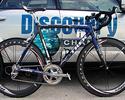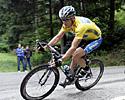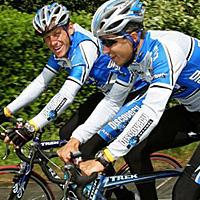
Recently on Cyclingnews.com |
|
|
Behind the Blue Curtain
Inside the Discovery Channel bus with Chris Brewer
Chris will be bringing us daily updates from within Discovery Channel HQ, getting the lowdown from team management.
Discovery Channel is the team on everybody's lips at this year's Tour de France. Why?
One name - Lance Armstrong.
This network of riders and staff previously existed as the US Postal Service Pro Cycling Team, helping Lance win his six Tour de France crowns, and in 2005 they're gunning for a seventh title. Follow the progress of the team here on Cyclingnews.com from 'Behind the Blue Curtain'
July 13, 2005: A little bit of Discovery tech
10 Questions with Scott Daubert, Trek's Team Liaison
1. Why do pros use tubular tires instead of clinchers?

|
Scott Daubert: They prefer them because they are lighter, have a better ride quality, and there are less pinch flats with tubular tires.
2. How often do the mechanics replace the chains?
SD: Here at the Tour they are replaced once a week, mechanical issues not withstanding of course.
3. What bikes and wheels can the Discovery Channel riders choose from, aside from their Time Trial bikes?
SD: For the flat days they usually ride the Bontrager Aeolus wheel and the Trek Madone 5.9. For the climbing days they will usually ride the Bontrager Race XXX Lite wheel and the Madone SL bike. If the weather is bad the team will also be able to use an aluminum Bontrager Race X Lite wheel if they so desire.
4. What do the bikes actually weigh?
SD: The Madone 5.9 usually comes in at 7.2 kilos/15.8 lbs. Lance's SSLx prototype climbing bike weighs just 6.8 kilos/14.96 lbs, the UCI minimum weight for a bike.
5. What air pressure do the tires usually run?
SD: On most days they usually run between 7-8 bar/103-118 PSI. On a rainy day they'll usually run 6-7 bar/88-103 PSI. Time Trial wheels usually run 9 bar/132 PSI.
6. Does the team really ride standard Trek bikes? Or are they made custom to the riders' dimensions?

|
SD: Yes, they really are standard Trek bikes. One of our Production Engineers, Mark Andrews, goes down the line in December-January and hand picks the bikes off the production line. But these are from the same product line that goes direct to your local Trek dealer.
7. Does aero guru/wheel maker Steve Hed work for Trek?
SD: No, but we have consulted Steve on the Aeolus wheel. His knowledge and experience in the wind tunnel really helped us with the design, plus he's a member of the F-One design team.
8. Back in the day bike forks were mostly curved and now they're straight. What's the difference?
SD: The difference is primarily aesthetic but there is some substantial weight savings, too - and the strength increased. It should be noted that the fork offset - also called "rake" - has not changed from the curved to the straight bladed fork.
9. What's the standard cog set for the Discovery Channel team?
SD: Up front they run a 39-53 chainring and an 11-23 rear cassette. For the Time Trials they usually run a 44-55 chainring and an 11-21 in the back.
10. What are some things Trek is looking at for future production?
SD: Using Computed Fluid Dynamics design and more wind tunnel time to study aerodynamics, improving overall ride quality through geometry and bike materials, and revisiting the SPA technology we successfully used at Paris-Roubaix last year.
Thanks, Scott! That's all for now,
Cheers,
Chris.
|
|
|
|
|
2005 entries - the Tour de France
- July 28 - Lance's Tour curtain call
- July 23 - Time Trial support
- July 19 - How to become a pro
- July 18 - All's well on rest day
- July 16 - The Disco team car
- July 15 - Iconography
- July 14 - The team behind the team
- July 13 - A little bit of Discovery tech
- July 11 - Staying on guard
- July 9-10 - Life at the start & Entering the Holy of Holies
- July 7 - Coloured Lids
- July 6 - Recovering after the TTT
- July 5 - Stage 4 - Mystery Oakleys?
- July 4 - Stage 3 and looking ahead to the TTT
- July 3 - Discovery Channel Satisfied with Stage 1 Result
Previous Cyclingnews articles on the Discovery Channel team
Interviews
- Lance Armstrong: Ready for Number 7
- Lance Armstrong: Suddenly seven
- Lance Armstrong interview: On top of his game, having fun
- Johan Bruyneel: It's not a formality, really
- Lance Armstrong: Three weeks to go before the Tour de France
Tech
- Tour de France tech - Lance's TTX


